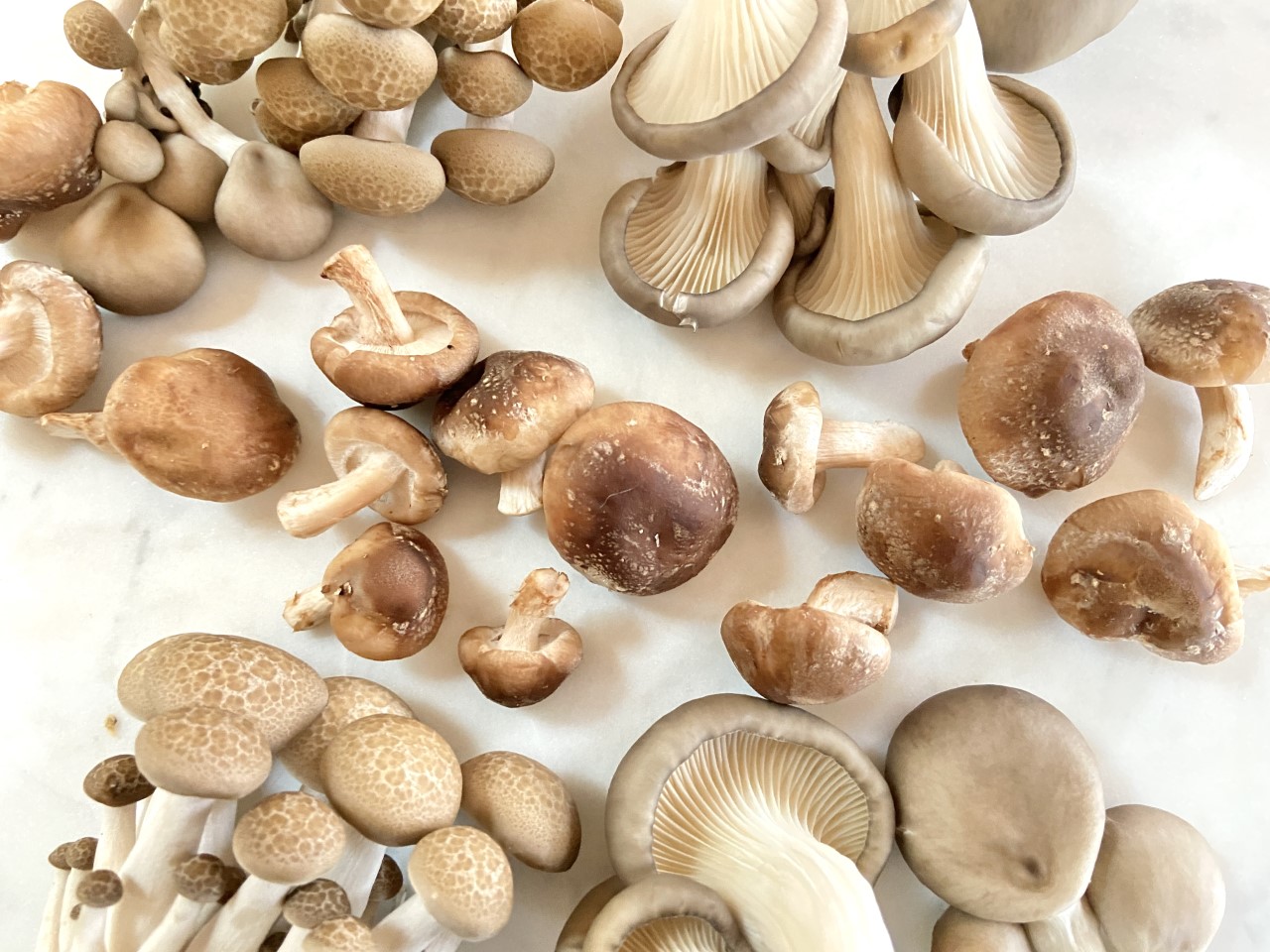Root-to-leaf cooking uses all edible parts of the plant, with a focus on seasonal ingredients, grown and sold close to home. What’s on our menu this month? A medley of locally grown mushrooms fried to crispy perfection and complemented by hazelnut dukkah and a scattering of fresh herbs. Mushrooms are on many farm lists right now, and grow-your-own kits are proliferating, too. Hazelnuts are also in abundance from nearby farms, and a handful goes a long way.
Dukkah is an addictive mix of crushed nuts, toasted seeds and warm spices. It’s commonly sprinkled over roasted vegetables or mixed with olive oil to dip bread. Its name derives from the Egyptian Arabic word “to crush” or “to pound;” the nuts and seeds are ground with a mortar and pestle to a coarse powder. It’s a powerhouse of a garnish, with infinite variations that add that often-missing element of crunch and texture to a dish.
A variety of mushrooms provides an array of shapes and textures, which makes for very fun finger food. Try to break your mushrooms into relatively similar sizes; otherwise, you will have to account for varied frying times. The recipe also works beautifully with sliced or quartered cremini and button mushrooms.
The best way to fry fungi is hotly contested. I tested these with a flour-and-batter sequence, a double-battered batch, and a flour-batter-panko method. By far, the flour, batter and panko method was superior. The mushrooms were crispier, more thoroughly golden and stayed crisp for much longer after frying.
Hazelnut dukkah
Ingredients
1/4 cup hazelnuts, lightly crushed
2 tablespoons sesame seeds
1 tablespoon coriander seeds
1 teaspoon cumin seeds or powder
Directions: Toast the hazelnuts in a dry skillet over low heat, swirling the pan until they take on a slight golden color. Remove to a mortar or small food processor.
In the same pan, toast the seeds the same way until they are fragrant; this takes less than a minute. Watch them carefully so they don’t brown. Add the seeds to the nuts and add the powdered cumin, if using.
Pound the mixture in the mortar, or pulse in the food processor until the mixture is coarsely ground.
Batter and panko fried mushrooms
Ingredients
8 oz mixed mushrooms, sliced or broken into pieces
3/4 cup flour, divided
1/4 teaspoon each paprika, garlic powder and black pepper
1 teaspoon salt
3/4 cup milk (dairy or non-dairy)
2 to 2.5 cups panko
1 cup neutral oil
Directions: Set up your station. Put a large-rimmed baking sheet on the countertop next to the burner you’ll use, and place a cooling rack on top. At your workspace, set out two bowls and one small-rimmed baking pan. Add 1/4 cup of the flour to the first bowl. In the second bowl, mix spices into the rest of the flour and add milk; combine. Add 1 cup of panko to the small baking sheet to cover the bottom.
Add mushroom pieces to the plain flour and toss to combine. Once thoroughly coated, add mushrooms to the batter. Mix to coat, separating any pieces that stick to each other. Spread the battered mushrooms over the panko in a single layer. Shake the pan to coat the bottom and sides of the mushrooms. Pour the second cup of panko over the top, and give the pan several hearty shakes to make sure mushrooms are uniformly coated with no visible wet spots.
Add the oil to a large cast iron skillet or Dutch oven and heat to 375 degrees. If you don’t have a kitchen thermometer, this is roughly medium-high heat, but far from screaming hot. Test the oil with a small piece of mushroom. The oil should bubble around the mushroom immediately, but not splutter or pop.
Drop the mushrooms gently into the oil, taking care none stick to each other. Start from the side of the pan farthest from you and work your way forward. This way you won’t have to reach over any sizzling pieces, and you’ll know which mushroom to flip first.
Fry the mushrooms for 2 to 3 minutes. They’re ready to flip when the bottoms are golden brown and the color is moving toward the top.
Flip mushrooms over and cook for another 30 seconds before checking the bottom, and adjust the pan heat or cooking time as needed. If they’re unevenly dark, turn down the heat; if they’re pale, leave them in. Mine took a minute and a half once flipped.
Remove the mushrooms using a slotted spoon or strainer and spread evenly on the cooling rack. Once they’re cool enough to handle but still warm, move them to a plate and sprinkle with the hazelnut dukkah. Scatter a handful of scallions, chives and/or cilantro over the plate and serve.
Hannah Green’s Root-to-Leaf column runs on the first Wednesday of every month.




